Peaky Blinders: The tricks of creating a TV drama
- Published
Real life gang the Peaky Blinders got their name from hiding razor blades in the peaks of their caps
How do you build an illegal 1920s betting den from scratch for a major TV drama? Paint the walls with nicotine, use maple syrup for fake spit and get inspiration from Google Images, according to the man who built the set for BBC Two's Peaky Blinders.
The walls of the Peaky Blinders production office are plastered with pinned-up pictures - sketches of set designs, film stills and real mugshots of dodgy-looking characters from the 1920s.
One picture on the wall is a photo of a Prohibition-era New York bar. "It was off the internet," says production designer Grant Montgomery. "I just pumped in 'saloons' [to Google] and suddenly this, external came up."
The bar from that photo has been rebuilt in a TV studio, with a few minor adjustments, to double as a pub in the grimy backstreets of Birmingham, England.
"It just had the right feel," Montgomery says. "I just thought, right, let's use it."

Production designer Grant Montgomery is in charge of creating the sets
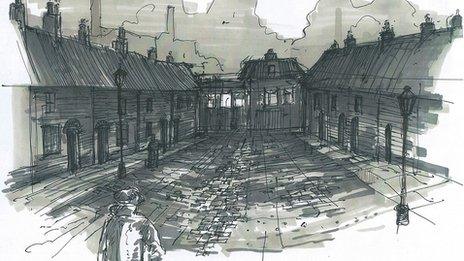
Montgomery begins with hand-drawn sketches
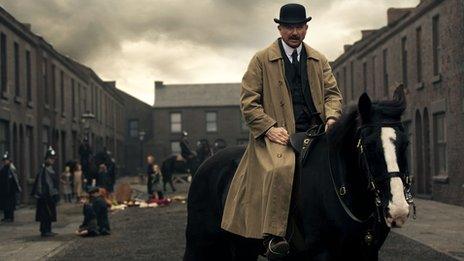
Locations, such as this street in Liverpool, bring the design to life
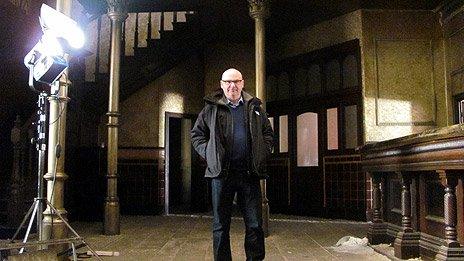
The set for the Garrison Tavern pub was built inside a TV studio in Leeds
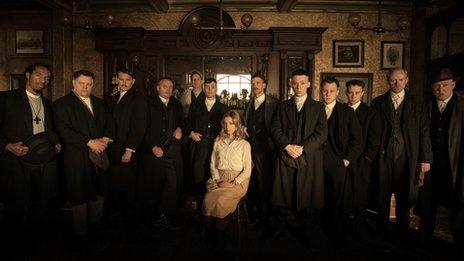
The pub is at the heart of the drama about the Birmingham gang in the 1920s
The pub is the Garrison Tavern, the hangout for the notorious Peaky Blinders gang. The drama is based on the real Peaky Blinders - so called because they had razor blades hidden in the peaks of their caps - who terrorised south-east Birmingham at the end of the 19th Century.
With the drama shifting to the 1920s, the six-part epic stars Cillian Murphy as gang leader Thomas Shelby and Sam Neill as the police officer sent on the trail of a shipment of stolen guns.
The Garrison Tavern has ended up as a cross between an American speakeasy and a spit and sawdust British boozer. There is sawdust on the floor. As for the spit, a special recipe has been used to fill the metal spittoons at the foot of the bar, into which tobacco-chewing regulars would discharge.
For the magic of TV, it has been made from chopped dates, maple syrup and sugar.
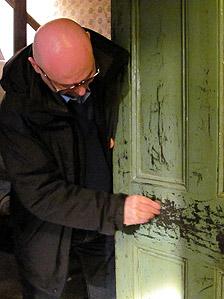
New doors are scratched with coins to make them look aged
In another part of the TV studio in Leeds, around the corner from the Garrison Tavern set, there is a structure housing a faithfully recreated fussy front room.
Period furniture and ornaments have come from prop houses and second hand stores and the wallpaper has been reproduced from a design in a 1902 pattern book.
Proud portrait photographs of Murphy and his co-stars in World War I uniforms stand on shelves. Little details are key to creating a convincing set.
A door leads to a betting den, complete with discoloured sporting posters, replica racing newspapers and top hats that have been left on the tables, looking as if the gangsters have just popped out.
One alien item on the set is a modern plastic box, which contains dozens of cigarette butts waiting to fill the bookie's ashtrays.
With the props in place, the crew must give it a lived-in feel. So they have repeatedly painted the walls and ceiling with a nicotine solution to mimic years of smoking stains, and brand new wooden doors have been painted and then scratched with coins to make them look aged.
Back upstairs in the production office, pictures from the 1980 western epic Heaven's Gate provide a further clue about where Montgomery has found inspiration for the look and feel of the Peaky Blinders' world.
Montgomery is in charge of designing the sets and has also worked on period dramas including Birdsong and The Crimson Petal And The White.
Western inspiration
For Peaky Blinders, he says he wanted to combine gritty British gangster realism with the brooding mood of Hollywood's wild west.
"The script was extremely cinematic," he explains. "I was reading it and suddenly thought, wow, it's like a western.
"I went and looked at Heaven's Gate, and I suggested to the director, 'That's got a great look to it, it's got a great scale'. So we started from that basis. We used that as our kind of benchmark, our stepping off point. It was one of the key influences."
Historical accuracy is still important, though, he insists. "There is a lot of research done. It's finding out about the right canal boats. Finding out about the right wallpapers. But if you're too slavish to it, I think it becomes a little dead, so you do want to infuse it a little bit with some drama."
At the start of the first episode, Cillian Murphy rides his horse down the main street - an apparent reference to Clint Eastwood in High Plains Drifter.
Turn back time
The street itself, around which most of the action is set, was actually filmed in Liverpool. Mr Montgomery's search for a road to use for filming led him to a condemned and uninhabited street of terraced houses.
He says his job was to turn it back in time. "Basically you have to take everything out. There are satellite dishes, there are trees," he says. "They didn't have trees there so we had to cut the trees down. We had to replace all the windows, we replaced all the doors.
"We painted every house black. The combination of coal fires and industrial smoke created smog and it affected the stone. So we had to paint all of this black.
"Road surfacing goes in to give it a different kind of feel. We brought slurry in, which was an organic combination of mulch and earth and sand. These are the things you do. There's a company who do all this. You discuss the colour, the texture, the nature of what you're trying to create."
A lot of effort goes into getting the appearance right. But if viewers focus on the drama and do not give the sets a second thought, Montgomery and his team will have done a good job.
- Published7 January 2013